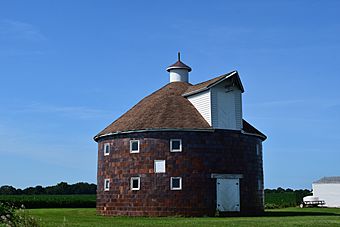Virginia Tillery Round Barn facts for kids
Quick facts for kids |
|
|
Virginia Tillery Round Barn
|
|
 |
|
| Location | County Road 738 |
|---|---|
| Nearest city | White Hall |
| Built | 1912 |
| Architectural style | Round barns |
| MPS | MPL001 - Round Barns in Illinois Thematic Resources |
| NRHP reference No. | 82002536 |
| Added to NRHP | August 26, 1982 |
The Virginia Tillery Round Barn is a unique circular building located near White Hall in Greene County, Illinois. It's called a "round barn" because of its unusual shape! A farmer named Harry C. Price had this barn built in the fall of 1912.
This barn is about 36 feet (11 meters) wide. That's a bit smaller than many other round barns in Illinois, which are often around 60 feet (18 meters) wide. Because of its size, experts think it was used for many different farm tasks, not just for dairy cows like some of the bigger round barns. The barn is made from brown tile blocks and has a wooden shingle roof with a small tower on top called a cupola.
Why Are Round Barns Special?
Round barns are not very common. Most barns are shaped like rectangles. Farmers started building round barns for a few reasons:
- Efficiency: Some people believed it was easier to work inside a round barn. You could move around without sharp corners getting in the way.
- Strength: A round shape can be very strong against strong winds.
- Saving Materials: Sometimes, a round barn could use less wood or other materials than a rectangular one of the same size.
The Virginia Tillery Round Barn is a great example of this interesting style of farm building.
A Special Historic Place
The Virginia Tillery Round Barn is considered very important to history. On August 6, 1982, it was added to the National Register of Historic Places. This is a special list kept by the United States government. Being on this list means a building or place is important because of its history, architecture, or what it means to a community.
The barn was added to the list as part of a bigger project. This project helped recognize many other round barns across Illinois for their historical value. It helps make sure these unique buildings are protected and remembered for future generations.



